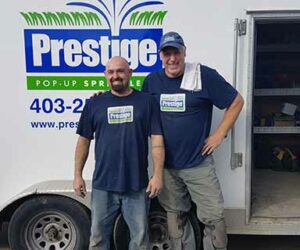Often we think that getting a lawn wet is good enough for it to be green and growing. That’s just not the case! Watering your landscape is more than just turning on the water and forgetting about it. To irrigate your landscape you need to consider the soil conditions, slope, weather conditions, and plant material. Believe it or not, even if you follow the science of how much water your property needs, you could be over-watering. Over-watering means wasting water and maybe more importantly, wasting your precious money!
What!? When has science lead us wrong before… Well, its not that it leads us wrong, we just don’t see or know the variables to factor in to make the science work! With irrigation the two biggest factors we don’t really see are the soil and root depth.
What’s in your Soil?
The texture of soil is very important in understanding how fast water will flow into the soil, through the root zone, and deep where no plant can take advantage of it. There are three soil particle types:
- Sandy particles allows water to almost free flow through it. Think of making moats around your beach sand castles and how hard it was to keep them full. Tirelessly pouring buckets of water just to see them fill and then quickly drain again.
- Silt is usually a slick dark black medium that is composed of particles smaller than sand. It has a smooth texture to it.
- Clay the thick and sticky muck that just holds onto water and won’t let it go. It’s like that mud puddle in the back alley that remains days after the last rainfall. This soil is very good at holding water and lets it escape ever so slowly.
When looking at soil there is a combination of all three soil types which gives you a soil texture. Check out how to determine your soil texture.
Generally in the Calgary, Airdrie, Chestermere, Okotoks, and Cochrane area we have a clay-loam soil texture. That means we have some decent nutrients in the soil but a clay base that slows the percolation of water through the ground. Let’s hold onto that thought and learn something about the root zone.
What Are Your Roots Like?
What is a root zone you ask? It’s the other thing you can’t see that really impacts the plant materials ability to extract water from the ground and promote a strong healthy growth. The root zone starts at the base of the plant when it goes into the ground and extends downward until the last tip of the root. When you have a strong healthy plant, you have a deep root zone. You could call it the foundation of the plant. Without a good foundation the plant will not be able to extract water from the soil to grow strong.
When you cut out a slice of your lawn six inches long, by one inch wide, and six inches deep you will be able to gauge the depth of your roots. Simply shake the dirt free of the root and see how long they are. These roots act like straws in a drink. If your cup is ten inches tall and full of your favorite beverage but your straw is only one inch long, one quick gulp and your joy is done. Make that straw longer, say ten inches, and you’ll suck up the last drop! Your roots are the same. Longer roots mean your plants can drink water deeply from the soil.
Some of the Magic
Jumping back to the science of a healthy lawn we need to understand the balance between the soil and the roots. Soil is the material that water flows through due to gravity and the roots are the straws that can suck the water from the soil (it’s pretty basic, but lets run with it for now…)
If the soil allows water to flow past the roots really fast, they only have a brief moment to suck up some water. If the soil restricts and slows the flow of water due to gravity, the roots have more time to suck up the water. But, if it holds the water, it may drown the plant because the roots never get a chance to stop drinking. Remember how your belly felt after gulping in too much water from the water park?
When you can encourage your grass or favorite plant to have deep roots you get the advantage of a sturdy plant, plus the opportunity for those roots to drink deeply from the soil. The longer the roots means you have a deep cup. This also means your plant has access to more available water.
As we mentioned before, the Calgary area has a clay loam soil texture. It is very good at hold watering which means it allows the water to slowly percolate through the roots. But, it also means that irrigation systems quickly cause it to saturate and overflow. This overflow is wasted water. Without diving deeper into the weeds (did you know we do weed control?) and putting on the geeky irrigation designer glasses, how can we take advantage of this?
Cycle and Soak Irrigation
Because of our soil conditions and the design of irrigation components, the majority of sprinkler nozzles apply water faster than the soil and roots can absorb. In Calgary every irrigation nozzle on the market will have the ability to saturate the average lawn. The easiest way to compensate for this is to use “cycle-and-soak”.
This irrigation practice is super easy to understand. You water a zone for a period of time (cycle), allow the applied water to absorb into the soil (soak) and then you water the remaining cycle. It’s like having a free re-fill of your favorite beverage at the restraunt. You drink some, the waiter fills it, and then you finish it off before leaving. Your body got the full enjoyment without that bloaty feeling.
Many newer irrigation controllers have the built in ability to perform cycle and soak by simple configuration. If your controller is an oldie, it is still super easy to program in to get the benefit. Here’s how: take the run time of each zone, divide it in half, and then add another start time. To better understand, check out the following example.
Irrigation Start Time (Mon, Wed, Fri):
Zone 1 – MP Rotator Front Grass
Zone 2 – Rain Bird Spray Grass
Zone 3 – Rain Bird Rotor Grass
Zone 4 – Toro Precision Grass
Irrigation Schedule Before Cycle and Soak
Irrigation Start Time (Mon, Wed, Fri):
Zone 1 – MP Rotator Front Grass
Zone 2 – Rain Bird Spray Grass
Zone 3 – Rain Bird Rotor Grass
Zone 4 – Toro Precision Grass
Irrigation Schedule After Cycle and Soak
3:00 am
45 minutes
12 minutes
28 minutes
20 minutes
3:00 am, 4:00 am
22 minutes
6 minutes
14 minutes
10 minutes
Wow! You made it to the end. You learned a little about soil textures, root depths, and a quick way to adjust your schedule to get instant benefits. If you are not sure that you have the correct run times for your zones, or a little overwhelmed by this information, DON’T STRESS! Our All-Star Technicians can help you out. Just reach out and book a start-up or mid-season visit. We would love to help you tune your system for a properly watered landscape that will save you money.




